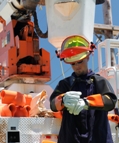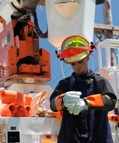
Electrical Safety First
What can we do to prevent or minimize these incidents? The simple answer is training and increased awareness.
- By Amy McGuinn Godbey
- Aug 01, 2010
Every day, there are electrical incidents that could have and should have been prevented. In a recent one, an electrical worker accidentally received an electrical shock from inadvertently touching a non-insulated screwdriver to a live 240-volt wire; he received burns on both hands and wrists as a result of the arc flash caused by this contact.
Some believe industrial incidents are a fact of life. While there may be some validity to this, our responsibility is to continue to work toward a risk-free environment. What can we do to prevent or minimize electrical incidents? The simple answer is training and increased awareness.
The above incident would not have occurred if the worker had been properly trained and was provided with the correct personal protective equipment. Let's look at this incident or, for that matter, any incident involving electrical shock or electrocution.
 When a worker turns the power off at the source, is it really off? Most switches used today are mechanical. These switches may malfunction, and the equipment may not be powered off at all. The only way to be sure the equipment is truly off is through the use of a voltage detector or tester. In the hands of a qualified person, these tools are simple to operate. A word of caution, though: Be sure these tools are functioning properly immediately before and after the test.
When a worker turns the power off at the source, is it really off? Most switches used today are mechanical. These switches may malfunction, and the equipment may not be powered off at all. The only way to be sure the equipment is truly off is through the use of a voltage detector or tester. In the hands of a qualified person, these tools are simple to operate. A word of caution, though: Be sure these tools are functioning properly immediately before and after the test.
The reason we test is to know whether the equipment is energized or not. The equipment must be treated as though the power is still on, in fact, OSHA 1910.147 requires that the equipment be treated as though energized until proven otherwise.
Also, follow the necessary additional PPE requirements, such as wearing insulating rubber gloves with leather protectors that are properly selected for the task and properly sized for the person who will be performing the task.
The selection of the rubber insulating gloves is simple: Every insulating rubber glove is required to have a color-coded label on the cuff that informs the user of the maximum use voltage on which that glove can be used. The number on the label must be greater than the voltage of the equipment being worked. Selected properly, insulating rubber gloves will do the job of protecting the worker against electrical shock.
Do not forget about leather protectors, for they are an essential part of wearing and using the insulating rubber gloves correctly. The combination of the rubber gloves and the leather protectors will provide complete protection against both the electrical current that is present and the potential mechanical damage to the insulating rubber gloves associated with working on energized electrical equipment.
As mentioned above, determining gloves' size is also important. To determine glove size, measure the circumference of the hand around the palm. This can be done by using a cloth tape measure or even a piece of string. Take the string and hold it between the thumb and the first knuckle. Wrap this around the knuckles and palm, returning to the thumb. Lay this measured piece of string down on a ruler. If it is 9 inches long, then your hand is a size 9, and so on. Allow for additional room if fabric liners are worn. Gloves are available in a full range of sizes starting with 7 and continuing through 12, including half sizes.
If a second point of contact is possible, the worker must use additional insulating equipment, such as blankets, sleeves, and barriers that will insulate him or her from contacting energized or grounded equipment.
Arc Flash Protection and Insulated Tools
Now, for the arc flash that burned a worker. If you have not heard about the NFPA 70E standard, you probably have been living under a rock for the past 10 years. NFPA 70E, Standard for Electrical Safety in the Workplace, has been a buzzword in electrical safety and is the document that provides guidelines and requirements on how to perform tasks safely while working on and maintaining electrical equipment. For example, NFPA 70E specifies areas within which arc flash protection is required to be worn by workers who are in proximity of energized or potentially energized equipment. All workers within the defined boundaries must wear specified protective equipment, even on circuits as low as 50 volts.
In my opinion, hand tools that are not insulated should be removed from the toolbox of every electrical worker. Every insulated tool is rated for exposure up to 1,000 VAC and dielectrically tested at 10,000 VAC. Tools must meet current ASTM F1505 and IEC900 standards for insulated hand tools. Do not be fooled by coated tools or orange tools; just because they have a coating or because they are the right color does not guarantee they are truly insulated tools. All tools designed for energized work must be clearly marked to identify them as such.
How can you select the proper PPE to protect a worker in case of an arc flash? NFPA 70E provides two choices for proper selection:
1. Use tables provided in the standard to guide your selection. These tables provide a comprehensive explanation of the selection process. When using these tables, one needs to have a basic understanding of the electrical system and work procedures.
2. Calculate exposure. Numerous software products on the market will provide a complete assessment.
Another solution for understanding your hazards and selecting proper PPE would be to enlist the help of a professional.
Remember, Awareness is Key
Can we provide a completely safe work environment? Increased awareness is the key. With proper training and understanding of the hazards faced by the electrical worker, today's safety engineer can provide solutions that will certainly help to achieve a safer electrical work environment.